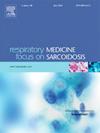脉冲皮质类固醇治疗与抗氨基酰基trna合成酶抗体相关的间质性肺病:相当的疗效和减少不良事件的潜力
IF 3.5
3区 医学
Q2 CARDIAC & CARDIOVASCULAR SYSTEMS
引用次数: 0
摘要
背景与目的对于与抗氨基酰基trna合成酶(ARS)抗体相关的间质性肺疾病(ILD)的最佳治疗方式仍存在争议。本研究旨在比较脉冲皮质类固醇治疗与常规皮质类固醇治疗在抗ars ILD患者中的疗效和安全性。方法回顾性队列研究纳入62例抗ars ILD患者。患者被分为两组:一组接受脉冲皮质类固醇治疗(500-1000毫克甲基强的松龙静脉注射3天),另一组接受常规皮质类固醇治疗。主要结局包括1年的初始治疗反应和疾病复发。次要结局是肺功能测试、KL-6水平、强的松龙剂量和不良事件的改变。结果脉冲皮质类固醇治疗组与常规治疗组的初始治疗改善率相似(90.3% vs 77.4%, p = 0.301),无复发生存期无显著差异。两组间肺功能测试的改善具有可比性。在12个月时,脉冲治疗组的平均每日泼尼松龙剂量为3.9 mg,而常规治疗组为6.0 mg。脉冲皮质类固醇治疗组的不良事件也较少(25.8% vs. 61.3%, p = 0.010)。结论与常规治疗相比,脉冲皮质类固醇治疗对抗ars ILD患者具有相似的治疗效果、更早减少皮质类固醇剂量和更低的不良事件发生率。这些发现强调了类固醇保留策略的潜在益处,表明脉冲皮质类固醇治疗可能被认为是治疗这种疾病的有效和更安全的选择。本文章由计算机程序翻译,如有差异,请以英文原文为准。
Pulse corticosteroid therapy in interstitial lung disease-associated with anti-aminoacyl-tRNA synthetase antibodies: Comparable efficacy with potential for reduced adverse events
Background and objective
The optimal treatment modality for interstitial lung disease (ILD) associated with anti-aminoacyl-tRNA synthetase (ARS) antibodies remains controversial. This study aimed to compare the efficacy and safety of pulse corticosteroid therapy with that of conventional corticosteroid therapy in patients with anti-ARS ILD.
Methods
This retrospective cohort study included 62 patients with anti-ARS ILD. Patients were divided into two groups: Those who received pulse corticosteroid therapy (500–1000 mg of methylprednisolone intravenously for three days) and those who received conventional corticosteroid therapy. Primary outcomes included initial treatment response at one year and disease recurrence. Secondary outcomes were alterations in pulmonary function tests, KL-6 levels, prednisolone dose, and adverse events.
Results
Both the pulse corticosteroid therapy group and the conventional therapy group had similar rates of initial treatment improvement (90.3 % vs. 77.4 %, p = 0.301), with no significant differences in recurrence-free survival. Improvements in pulmonary function tests were comparable between the two groups. At 12 months, the mean daily prednisolone dose was 3.9 mg in the pulse therapy group compared with 6.0 mg in the conventional therapy group. The pulse corticosteroid therapy group also experienced fewer adverse events (25.8 % vs. 61.3 %, p = 0.010).
Conclusion
Pulse corticosteroid therapy provides similar treatment efficacy, earlier reduction in corticosteroid dosage, and a lower incidence of adverse events compared to conventional therapy in patients with anti-ARS ILD. These findings highlight the potential benefit of a steroid-sparing strategy, suggesting that pulse corticosteroid therapy may be considered an effective and safer option in managing this condition.
求助全文
通过发布文献求助,成功后即可免费获取论文全文。
去求助
来源期刊

Respiratory medicine
医学-呼吸系统
CiteScore
7.50
自引率
0.00%
发文量
199
审稿时长
38 days
期刊介绍:
Respiratory Medicine is an internationally-renowned journal devoted to the rapid publication of clinically-relevant respiratory medicine research. It combines cutting-edge original research with state-of-the-art reviews dealing with all aspects of respiratory diseases and therapeutic interventions. Topics include adult and paediatric medicine, epidemiology, immunology and cell biology, physiology, occupational disorders, and the role of allergens and pollutants.
Respiratory Medicine is increasingly the journal of choice for publication of phased trial work, commenting on effectiveness, dosage and methods of action.
 求助内容:
求助内容: 应助结果提醒方式:
应助结果提醒方式:


